First BloodDaNang Air Base Republic of South Vietnam  The VMGR-152 KC-130F landed at DaNang Air Base and taxied to the U.S. Marine Air Operations near the Air Vietnam passenger terminal. As the rear door of the taxiing aircraft was lowered I got my first impressions of Vietnam. The first thing that invaded my senses was the smell of the land. It smelled like a musty compost pile, old and decaying. Everything around was wet apparently from a recent rain and it enhanced the smell of decay. As I exited the aircraft, holding a small overnight bag and my M-14 rifle, I saw the people who we would be helping in their fight against an enemy that looked exactly like themselves. [delrosario]
The VMGR-152 KC-130F landed at DaNang Air Base and taxied to the U.S. Marine Air Operations near the Air Vietnam passenger terminal. As the rear door of the taxiing aircraft was lowered I got my first impressions of Vietnam. The first thing that invaded my senses was the smell of the land. It smelled like a musty compost pile, old and decaying. Everything around was wet apparently from a recent rain and it enhanced the smell of decay. As I exited the aircraft, holding a small overnight bag and my M-14 rifle, I saw the people who we would be helping in their fight against an enemy that looked exactly like themselves. [delrosario]Our squadron was to be billeted in a quadrangle of buildings which were built by the French for their expeditionary forces. The compound would hold our entire squadron along with Operation Shufly command and support elements. Also a couple of platoons from 1st Battalion, Third Marines were housed there to bolster the compound defensive forces. The buildings were tan colored and had red roofs. Even though the structures were less than 25 years old they were already showing signs of decay like almost all buildings situated in tropical areas do. For the most part, they were clean, thanks to a few dozen Vietnamese houseboys (actually, grown men older than most of the Marines they served). The sight of these old men, bending to their domestic tasks, smoking their acrid smelling French cigarettes, smiling, always smiling - in the hot still afternoons one could almost hear voices of another time singing Lili Marlene. At the center of the compound were the messhalls. North of them was a small clearing and a flagstaff flying the American and South Vietnamese flags where only ten years earlier the Tricolor of France unfurled in the Indochinese breeze.
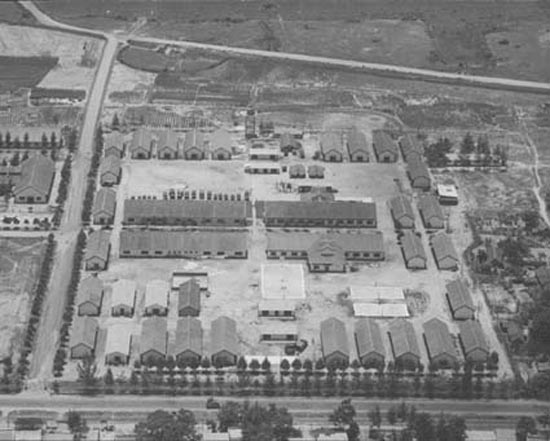
Liaison had been effected with the U.S. Army and Air Force commands, the South Vietnamese Air Force (VNAF), and the Army of Vietnam (ARVN) in the five northernmost provinces of this country. This political-military division of the country was known as I Corps (pronounced "eye core"). Those provinces, from the Demilitarized Zone (DMZ) on the 17th parallel to the south, include Quang Tri, Thua Thien, Quang Nam, Quang Tin, and Quang Ngai. Although not part of I Corps, occasional flight operations were flown in Kontum and Binh Dinh provinces. The primary mission assigned to HMM-365 was to provide flight assets in support of combat operations in South Vietnam, in particular, I Corps. Those flight operations were to include air assault (strike), logistic flights, administrative flights, reconnaissance, search and rescue, and training of indigenous units. In addition, the squadron was to provide its own security and recovery of personnel and equipment forced down beyond the defensive perimeter of DaNang Air Base, the job that necessitated the formation of the Combat Recovery Team (CRT). [delrosario]
Out of 24 helicopters we have to have 22 in the up status at all times.
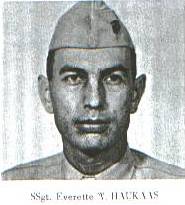

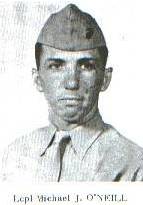

My first combat mission was to be a flight to Tam Ky where my CRT would be staged as a standby emergency force in support of a strike. I was armed with my M-14 rifle, 6 magazines full of ammo, two fragmentation grenades and a smoke grenade. I was also assigned to pack the demolition explosives, detonation cord, electrical wire, demolition pliers, and the electric plunger "hellbox" - everything except the blasting caps, which someone else on the team carried. Others carried the rappelling rope, PRC-10 radio, chainsaw and its gasoline/oil mixture, cases of C-rations, more ammunition for the rifles and linked ammo for the M-60 machineguns, and more grenades. This is a normal list of equipment for our Combat Recovery Team. We carried a lot of seemingly superfluous gear but 1stSgt Force said that it was better that we had it and not use it than to have a need for it and not have it. The helicopter received clearance from the DaNang air control and it started to roll on the runway. After a short distance it had gathered enough speed to enable the pilot to lift the chopper into the air with ease. Not far from the base boundary I saw the landscape of the surrounding terrain. I saw what looked like craters on the moon - ten, twenty, then hundreds of them. Having never been in the air over Vietnam before, except for being on the flight that brought me to this country, I thought at first that I was seeing craters made by the impact of hundreds of mortar or artillery rounds. The gunner, seeing my confusion yelled to me that those were Vietnamese gravesites. 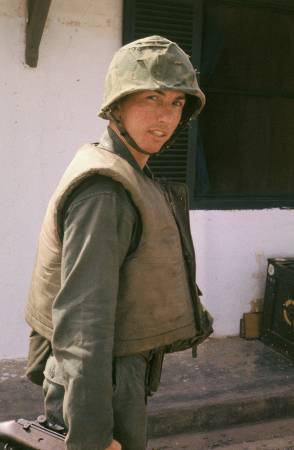 When we got to Tam Ky the CRT offloaded their gear and placed them on the ground near one of our helicopters. We then began the curious process that seemingly all men at war must endure - wait, wait for something to happen.
When we got to Tam Ky the CRT offloaded their gear and placed them on the ground near one of our helicopters. We then began the curious process that seemingly all men at war must endure - wait, wait for something to happen.And, of course, it started to rain. I was decked out in my new tree-pattern (tiger stripe) uniform and I didn't want it to get dirty so I stood instead of laying or sitting on the muddy ground that the CRT had occupied. The area we were in was considered "safe". Indeed, it seemed so because after a time native women carrying loads counterbalanced on bamboo sticks, would come walking by our defensive perimeter, totally unheeding our challenges, give us wide black-toothed grins, then continue on to their destinations. Not only did they not seem to respect our defensive perimeter but some would suddenly stop, lay down their load, pull up one leg of their baggy silk pants, squat and relieve themselves in open view, then proceed on and away. After an hour of these immodest visitors wandering near our perimeter, we carelessly let our guard down, thinking that with all these civilians around that the place must be "safe". The sharp sound of a rifle shot shattered that illusion. 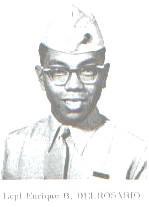 Everybody who had congregated around the helicopter, smoking and shooting-the-shit, hit the deck (the muddy ground). Me - I had my new camouflage utilities on and I didn't want to get dirty, so I just squatted down. I looked over at the most senior CRT member there, who happened to be Sgt. Guzman and he had this kind of silly smile on his face, like someone caught in an embarassing situation would have. He motioned for us to spread out and advance toward the sound of the shot.
Everybody who had congregated around the helicopter, smoking and shooting-the-shit, hit the deck (the muddy ground). Me - I had my new camouflage utilities on and I didn't want to get dirty, so I just squatted down. I looked over at the most senior CRT member there, who happened to be Sgt. Guzman and he had this kind of silly smile on his face, like someone caught in an embarassing situation would have. He motioned for us to spread out and advance toward the sound of the shot.I went forward on the crouch, being careful not to step on any of the piles of human excrement that the Vietnamese peasants had planted in and around our "defensive" perimeter. Funny, I thought, those peasants all had disappeared. We went into the brush for only a few yards and didn't find anything. There were no more shots after that one. Anyway, my first first firefight had taken place - memorable for its brevity and inconclusiveness. The moment that I had trained for had come and gone and it was nothing much to write about. [delrosario]
The liberty truck, a 6x6 driven by the worst driver in the Marine Corps, took us liberty hounds from DaNang Air Base through the outskirts of the city and dropped us off in front of the Grand Hotel. As prescribed by regulations, we were all wearing civilian clothes. We made our way to "Cheap Charlie's", a jewelry merchant on Doc Lap Street. There we were to change our American greenback dollars to Vietnamese piasters. We could get a better rate than the official conversion of 72 piasters to one U.S. dollar. The rate, which fluctuated daily between 129 to 131 piasters to a dollar, was posted on a chalkboard in front of Cheap Charlie's. After exchanging five dollars in U.S. currency to piasters I took off with PFC Thetford to explore the city.
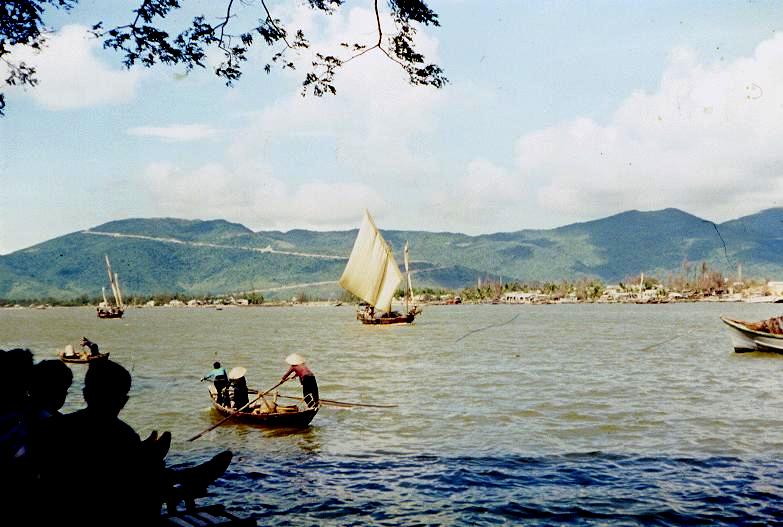 Photo by ART CORBETT; copyright © 2001 DaNang, in the Year of 1964, was a place "where the best is like the worst, Where there aren't no Ten Commandments an' a man can raise a thirst." [Mandalay, by Rudyard Kipling] Thetford and I were trying to get the most for our piastres and we were hitting every bar in town, and checking out the local con gai (young women) population. What we could not get with our charm and rudimentary French and Vietnamese language skills, we would try to buy with our American dollars or Vietnamese piasters. In every bar we entered we gained the immediate attention of all the bar girls, each vying for the "privilege" to sit with us and share happy-talk over Biere 33 and Saigon Tea. How could there be time for war when there were so many available women and so much beer to drink? 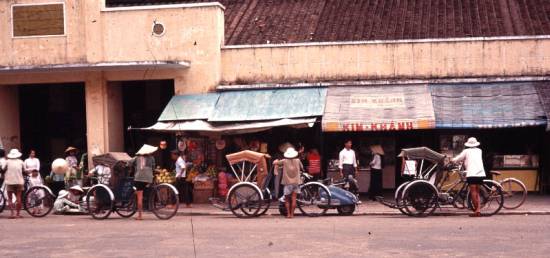 Photo by ART CORBETT; copyright © 2001 Doc Lap (meaning "independence" in Vietnamese) is the main commercial street of DaNang. The street is lined with shops, restaurants, bars, and vending stalls. It had not been paved since the French left the country in 1954 and was full of potholes. The storefront windows had no glass, instead bars and wire mesh were emplaced to keep out intruders after closing time, and grenades during open hours. Most of the signs were in Vietnamese and Chinese and, occasionally, in French. Some of the bars had already adopted American names and logos, bowing to the winds of change and force. The streets were wet from the rain and I was watching my step, trying to avoid puddles and other biodegradable matter on the ground. Suddenly I saw a splotch of dark red on the ground, then more as I continued walking. Thinking that it was blood and that someone nearby had just been shot and was seriously bleeding, I went into an alert condition. It was then that I discovered the source of this "blood". Chewers of betel nut, a mild narcotic, would chew the green leaves then spit the juice of their chew onto the ground. When chewed the leaves would exude a red liquid that would taint the mouth and teeth of the chewer, making their mouths look like it was bleeding. The Vietnamese who have chewed betel nut for many years would have black teeth. The Vietnamese are given to smiles when they greet another. It was hard for me at first to look at their stained mouths and teeth and not feel a revulsion.
10/9/64: Last night I couldn't sleep worth a damn. It poured almost all night and the ceiling was leaking on me, my rack and my clothes, and the mosquitoes went "ape". The house boy hung my sheet out to dry today. This morning we had a 17 plane launch. We were moving Vietnamese troops to and from Camp Jackson and some place in the boonies. Our part of the SAR (CRT), Lt. Wilson, L/Cpl McKinney, Cpl. Bingham, Pvt. Traughber, L/Cpl O'Neill, and myself (Winkel) were standing by at Camp Jackson. Luckily none of our planes were hit by ground fire. There is some awfully nice country here in Vietnam. As we were leaving DaNang an Army Huey went down due to a chip detector light that came on. When the Huey went down the VC hit. They killed the pilot, wounded the warrant officer co-pilot and wounded the gunner. We radioed back to see if we could go get them. Major Gustafson said "yes, but be careful". Colonel Koler said that the Army is sending their special forces after them. By the time the special forces brought them back the co-pilot was dead. The deuce that went to pick up the Huey dropped it from 1,000 feet. CRT Eagle is on ready standby this afternoon. The rest of the day for our team was a normal working day. [winkel]
Troop-lift for the ARVN in the morning. Lts Cronin and Werve piloting. Again in the afternoon with Lts Martin and Heinzerling. [mayher] 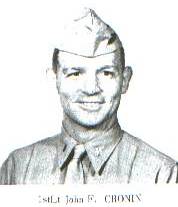
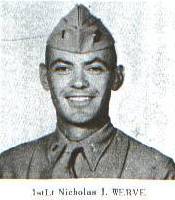

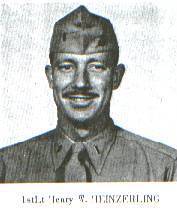
10/10/64: For the past two nights our compound had been fired on. There are holes in the post office wall and Sgt. Kelly was almost hit. Supposedly there are four regiments of VC surrounding the base. Rumors are they will attack in about three weeks after the rest of the VC get back from harvesting their rice. [winkel]
Marine Task Element, Vietnam, of which HMM-365 is under the administrative control of but operationally independent, is situated on the southwestern corner of DaNang Air Base. To us the place where we were billeted is simply known as "the compound". It is rumored that it was at this compound that forty French officers had their throats slit one night by Viet Minh guerrillas - or were they houseboys?
Search and Rescue, North (SAR North) around Hue Phu Bai with Captain Dittmeier and Lt Jacobs. [mayher] 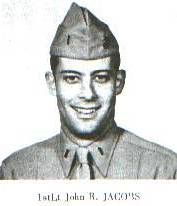


|
MARINE MEDIUM HELICOPTER SQUADRON in Vietnam: History
Pre-Vietnam 1964
NOV 64
DEC 64
JAN 65
FEB 65
MAR 65
APR 65
MAY 65
JUN 65
JUL 65
AUG 65 and After
Enrique B. del Rosario
Copyright © 2000
marinehelicopters@lycos.com